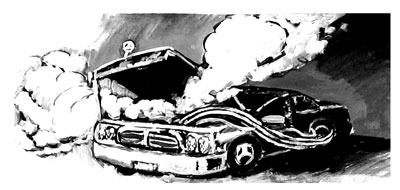Vocal Parts ? Vocal Assembly
 In this column, I would like to talk
about the vocal parts and the proper assembly of them that contributes
to the Total Vocal Performance. When a potential student comes to me for
assessment and evaluation, I look at many of the components that could
be crucial to his future success as a singing performer. First, I
conduct an interview with the person and make an assessment of his or
her interaction with me. If the responses are right on target and given
at a reasonable speed, the person has a very good chance to become a
future successful singer. It is, in a manner of speaking, like a low
speed computer vs. a high powered Super Computer. If there is no proper
'hardware' on someone's shoulders, there is no point in
instilling a high quality
'software program' into them. After they have 'passed' the
interview, I put them on the floor to see how they can connect their
brain to the other parts of their body, as the Vocal Science technique
is ultimately an integration and synergy between the mental, physical,
emotional and vocal state of the human being. If any of the components
are missing or not properly connected, the installation of the proper
instructions might be virtually impossible. This is the wholesome
mechanism that we are talking about and the parts cannot be useful
unless they are working in conjunction with each other. It's just like
starting a car. You can't kind of start a car
- you either start it or not. Obviously, if one of the
components is missing or disconnected, or even if just the fuel is
missing, the car is not going to take you anywhere. In this instance, as
in the singing mechanism, we need a driving force, ie. a global
performance of all of the components.
In this column, I would like to talk
about the vocal parts and the proper assembly of them that contributes
to the Total Vocal Performance. When a potential student comes to me for
assessment and evaluation, I look at many of the components that could
be crucial to his future success as a singing performer. First, I
conduct an interview with the person and make an assessment of his or
her interaction with me. If the responses are right on target and given
at a reasonable speed, the person has a very good chance to become a
future successful singer. It is, in a manner of speaking, like a low
speed computer vs. a high powered Super Computer. If there is no proper
'hardware' on someone's shoulders, there is no point in
instilling a high quality
'software program' into them. After they have 'passed' the
interview, I put them on the floor to see how they can connect their
brain to the other parts of their body, as the Vocal Science technique
is ultimately an integration and synergy between the mental, physical,
emotional and vocal state of the human being. If any of the components
are missing or not properly connected, the installation of the proper
instructions might be virtually impossible. This is the wholesome
mechanism that we are talking about and the parts cannot be useful
unless they are working in conjunction with each other. It's just like
starting a car. You can't kind of start a car
- you either start it or not. Obviously, if one of the
components is missing or disconnected, or even if just the fuel is
missing, the car is not going to take you anywhere. In this instance, as
in the singing mechanism, we need a driving force, ie. a global
performance of all of the components.
Next, after the brain, I definitely assess the physical muscles that are responsible for the vocal performance. These 'Vocal Parts' are as follows. The vocal box, which could be small or big (bigger is obviously better) and flat or arched (arched is much preferred as the curved roof of the mouth will allow a greater body for the sound - just like a properly arched ballerina's feet will allow her to achieve a greater ballet performance). The vocal chords, which can be short or long (ultimately, the longer the better, as that automatically implies a greater range). The vocal chords can also be thin or thick (average size is the best). If the vocal chords are thin the voice will be much higher, but may lack the lower tones and the body. If the vocal chords are on the thicker side, it will be much harder for the singer to achieve the higher range, yet the lower notes and the body of the sound will be perfectly intact. The anatomy of the face (facial cavities and facial muscles) - the wider the face is and the deeper the cavities are, the fuller sound will be that is produced. The length of the jaw should be proportional to the size of the head, otherwise it will be much harder to control the sound. The lips (thin or full) and the mouth opening also play a crucial role in the vocal performance. Fuller lips and a bigger mouth are the best combination for a much easier and more pleasantly produced sound. The abdominal muscles (lower abdomen and upper diaphragm ' the strength of the former and the width of the latter) also play a very important role, as well as the proportions of the physical body. Longer legs and a shorter upper body are much preferred as the sound flies on top and above the body and, in this instance, the altitude of the sound will be much greater and the sound will be much easier to throw to its aimed destination. Proper posture plays a very important role in the equation. At the beginning stages of the installation of the Vocal Science technique, the posture has to resemble that of a ballet dancer. Speaking of ballet, any dancer who is involved in serious ballet dancing begins his/her day at the bar, where, according to the great dancers, everything begins and ends. At the bar they check their posture, centre, etc. They also work on separate elements of which the future dance will consist of. Then they let go of the bar and their routines start usually at the corner of the ballet studio. If before they were repeating each element up to 32 times (ie. 32 bars of music), now in these 32 bars they fit in five, six or more elements combined together. And then and only then does the dance begin. All the elements are properly interconnected in sequence and now we can witness, for instance, a part of a future 'Giselle' or 'Nutcracker'. The dance was born. Similarly for singing, as we have the proper body parts working with the proper elements of the future song, we will have the SONG. The singer could relax now. By the repetition of certain vocal exercises, achieving proper posture with the certain body exercises, this will put him into the proper mode on automatic pilot. At this point the singer only has to be concerned about his artistic presentation, as all the physical parts are now intact. The perfect ensemble between the mental, physical and vocal parts, as well as the combination of technical and artistic merit, will help to achieve the totality of the vocal performance.










